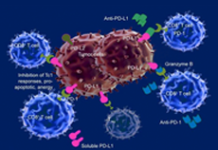
The 2024 American Society of Clinical Oncology (ASCO) Genitourinary Cancers Symposium will be held January 25 to 27 in San Francisco, California. This meeting features research in the treatment and care of people with genitourinary (GU) cancers, which is a group of cancers that occur in the urinary tract or the male reproductive tract, including bladder cancer, kidney cancer, and prostate cancer.
Below are summaries of research that will be presented at the symposium:
You can learn more about research from this symposium by following the #GU24 hashtag on X, formerly known as Twitter.
Who does this study affect: People with metastatic castration-resistant prostate cancer.
What did this study find: Results from the phase 3 CONTACT-2 clinical trial have shown that a combination of cabozantinib (Cometriq) plus atezolizumab (Tecentriq) helps stop or slow advanced prostate cancer after it no longer responds to initial treatment with a hormonal therapy. Cabozantinib is a type of targeted therapy called a tyrosine kinase inhibitor. Atezolizumab is a type of immunotherapy called an immune checkpoint inhibitor that targets a protein called PD-L1.
Metastatic castration-resistant prostate cancer is advanced cancer that has spread to other parts of the body and is no longer stopped by low testosterone levels. Treatments for this type of prostate cancer usually include medications called novel hormonal therapy, such as androgen receptor inhibitors or androgen synthesis inhibitors. However, over time, these hormonal therapies can stop working. If that happens, patients have few proven treatment options, especially if the disease has spread to the lungs or liver.
In the CONTACT-2 clinical trial, the researchers wanted to see if combining cabozantinib, a targeted therapy, with atezolizumab, an immunotherapy, would more effectively stop the disease than using other standard treatments. This study included 507 participants with metastatic castration-resistant prostate cancer that had progressed after treatment with a hormonal therapy. The median age of the participants was 71 years. More than half had a Gleason score of 8 or higher, and more than half had been diagnosed when the disease had already become metastatic. For nearly 4 of every 5 participants, the disease had spread to the bone. Nearly 3 of every 4 participants had enlarged lymph nodes. And 2 of every 5 participants had disease that had spread to other organs, such as the liver or lungs.
The patients were divided evenly into 2 treatment groups. There were 253 patients who received combination treatment with cabozantinib plus atezolizumab. These participants did not receive biomarker testing to see if their cancer had the specific targets used by cabozantinib and atezolizumab. The standard treatment group included 254 patients, and they received either abiraterone (Zytiga) plus dexamethasone (multiple brand names) or enzalutamide (Xtandi). Both treatment regimens are standard hormonal therapies used in prostate cancer.
The first 400 patients in this study were followed for a median of 14.3 months, and the rest of the participants were followed for a median of 12 months. Treatment with cabozantinib plus atezolizumab slowed the disease for a median of 6.3 months, compared with 4.2 months for those who received standard treatments. Among those who had disease that spread to the liver, the combination treatment slowed or stopped the disease for a median of 6 months compared to 2.1 months for standard treatments. People who received docetaxel chemotherapy (Taxotere) before the cancer stopped responding to hormonal therapy also benefited with the combination treatment. Patients who received docetaxel have high-risk disease, and for them, the disease was stopped for a median of 8.8 months, compared to 4.1 months with standard treatments. Among those who had been followed for 6 months or longer, the cancer responded in more patients with the combination treatment (13.6%) than with the standard treatments (4.2%). The researchers continue to follow the participants to see if the combination of cabozantinib plus atezolizumab helps patients live longer.
Most participants in this study experienced side effects during treatment. Significant side effects arose in 48% of those who received cabozantinib plus atezolizumab and 23% of those receiving the standard treatments. In the treatment combination group, these side effects included high blood pressure (7% of patients), anemia (6%), diarrhea (4%), and fatigue (4%).
What does this mean for patients? Combining the targeted therapy cabozantinib and the immunotherapy atezolizumab may be an effective treatment option for patients with metastatic castration-resistant prostate cancer that has stopped responding to hormonal therapy.
“Metastatic castration-resistant prostate cancer remains a fatal disease, and real-world evidence indicates that the median overall survival for patients with metastatic castration-resistant prostate cancer that has progressed despite treatment with a novel hormonal therapy is less than 2 years. Furthermore, patients with metastatic castration-resistant prostate cancer with visceral metastasis fare even more poorly, particularly those with liver metastases, with a median overall survival of less than 14 months. This patient population constituted nearly a quarter of the CONTACT-2 patient population and experienced a magnitude of benefit consistent with that seen in the overall study population.”
— lead study author Neeraj Agarwal, MD, FASCO
Huntsman Cancer Institute
Salt Lake City, Utah
Like what you’ve read here at Cancer.Net? Follow Cancer.Net on Facebook and Twitter for news about the latest in cancer care and treatment.




